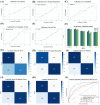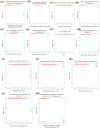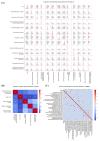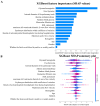AI-based Assessment of Risk Factors for Coronary Heart Disease in Patients With Diabetes Mellitus and Construction of a Prediction Model for a Treatment Regimen
- PMID: 40630462
- PMCID: PMC12230850
- DOI: 10.31083/RCM36293
AI-based Assessment of Risk Factors for Coronary Heart Disease in Patients With Diabetes Mellitus and Construction of a Prediction Model for a Treatment Regimen
Abstract
Background: This study aimed to construct a prediction model for a treatment plan for patients with coronary artery disease combined with diabetes mellitus using machine learning to efficiently formulate the treatment plan for special patients and improve the prognosis of patients, provide an explanation of the model based on SHapley Additive exPlanation (SHAP), explore the related risk factors, provide a reference for the clinic, and concurrently, to lay the foundation for the establishment of a multicenter prediction model for future treatment plans.
Methods: To investigate the relationship between concomitant coronary heart disease (CHD) and diabetes mellitus (DM), this study retrospectively included patients who attended the Beijing Anzhen Hospital of Capital Medical University between 2022 and 2023. The processed data were then input into five different algorithms for model construction. The performance of each model was rigorously evaluated using five specific evaluation indicators. The SHAP algorithm also provided clear explanations and visualizations of the model's predictions.
Results: The optimal set of characteristics determined by the least absolute shrinkage and selection operator (LASSO) regression were 15 features of general information, laboratory test results, and echocardiographic findings. The best model identified was the eXtreme Gradient Boost (XGBoost) model. The interpretation of the model based on the SHAP algorithm suggests that the feature in the XGBoost model that has the greatest impact on the prediction of the results is the glycated hemoglobin level.
Conclusions: Using machine-learning algorithms, we built a prediction model of a treatment plan for patients with concomitant DM and CHD by integrating patients' information and screened the best feature set containing 15 features, which provides help and strategies to develop the best treatment plan for patients with concomitant DM and CHD.
Keywords: SHapley Additive exPlanation; coronary heart disease; diabetes mellitus; machine learning; predictive modeling.
Copyright: © 2025 The Author(s). Published by IMR Press.
Conflict of interest statement
The authors declare no conflict of interest.
Figures





Similar articles
-
Comparison of Two Modern Survival Prediction Tools, SORG-MLA and METSSS, in Patients With Symptomatic Long-bone Metastases Who Underwent Local Treatment With Surgery Followed by Radiotherapy and With Radiotherapy Alone.Clin Orthop Relat Res. 2024 Dec 1;482(12):2193-2208. doi: 10.1097/CORR.0000000000003185. Epub 2024 Jul 23. Clin Orthop Relat Res. 2024. PMID: 39051924
-
Are Current Survival Prediction Tools Useful When Treating Subsequent Skeletal-related Events From Bone Metastases?Clin Orthop Relat Res. 2024 Sep 1;482(9):1710-1721. doi: 10.1097/CORR.0000000000003030. Epub 2024 Mar 22. Clin Orthop Relat Res. 2024. PMID: 38517402
-
Construction and validation of HBV-ACLF bacterial infection diagnosis model based on machine learning.BMC Infect Dis. 2025 Jul 1;25(1):847. doi: 10.1186/s12879-025-11199-5. BMC Infect Dis. 2025. PMID: 40596896 Free PMC article.
-
Patient education in the management of coronary heart disease.Cochrane Database Syst Rev. 2017 Jun 28;6(6):CD008895. doi: 10.1002/14651858.CD008895.pub3. Cochrane Database Syst Rev. 2017. PMID: 28658719 Free PMC article.
-
Cost-effectiveness of using prognostic information to select women with breast cancer for adjuvant systemic therapy.Health Technol Assess. 2006 Sep;10(34):iii-iv, ix-xi, 1-204. doi: 10.3310/hta10340. Health Technol Assess. 2006. PMID: 16959170
References
-
- Dai H, Much AA, Maor E, Asher E, Younis A, Xu Y, et al. Global, regional, and national burden of ischaemic heart disease and its attributable risk factors, 1990-2017: results from the Global Burden of Disease Study 2017. European Heart Journal. Quality of Care & Clinical Outcomes . 2022;8:50–60. doi: 10.1093/ehjqcco/qcaa076. - DOI - PMC - PubMed
LinkOut - more resources
Full Text Sources

